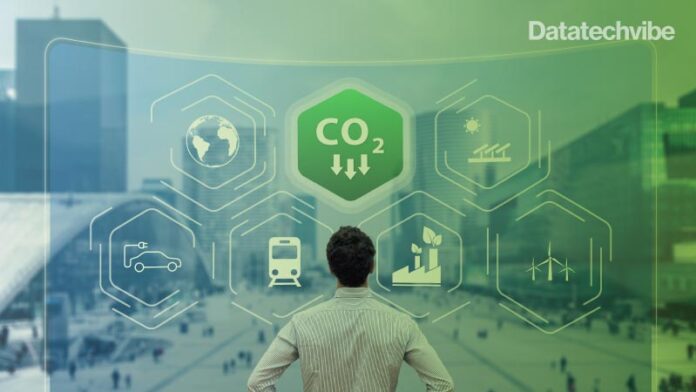Investors and tech giants alike are realising the immense potential of new technologies for global climate adaptation and mitigation

It seems to be an exciting time for cleantech, as the question today in many minds is not whether we need to leverage technology solutions to improve environmental sustainability but rather how we can accelerate their adoption. Investors and tech giants alike are realising the immense potential of new technologies; innovative solutions and business models are being scaled across sectors, from transport and agriculture to energy and manufacturing.
According to Accenture, 94 per cent of the top CEOs see sustainability as a very important part of the future success of their business. But correctly measuring the overall environmental impact of an organisation is particularly challenging. Organisations need to be able to record their footprint, report it to stakeholders, optimise their resource usage, and remove their footprint, either through carbon offsets or recycling.
Cleantech plays an essential role in sustainable development and preserving the environment. But we must know our lot today, see it and feel it to act with urgency. Simulation and the adoption of next-gen technologies have become highly essential.
Observation through analysis
To develop the best strategies for mitigation and adaptation, a digital twin, a model simulation, that can serve as a stand-in for the real thing, can be utilised as a tool. It holds some of the most significant potential to aid climate model creation, as it makes it possible to test large-scale changes in processes before they are implemented. Unlike predicting the weather, which only models atmospheric physics, climate models are multi-decade simulations that can model all the elements of the atmosphere and human activities.
Climate simulations can be configured today at 10- 100-kilometre resolutions. Some scientists estimate that these resolutions will demand millions to billions of more computing power than currently available. Today, tech conglomerates are focusing on developing technologies to perform ultra-high-resolution climate modelling and advancing in lightspeed to predict extreme weather decades in advance. Such speedups can now be achieved by combining three technologies:
- GPU-accelerated computing.
- Deep learning and physics-informed neural networks.
- AI supercomputers and vast quantities of observed and model data to learn from.
Nvidia plans to build the world’s most powerful AI supercomputer that can predict climate change. Named Earth-2, or E-2, the system will create a digital twin of Earth in the Omniverse. By modelling the planet at an unprecedented resolution, E2 would be able to accurately predict the climate for decades into the future and guide efforts to mitigate global warming. Nvidia plans to achieve the billion-x leap needed to perform ultra-high-resolution climate modelling using super-resolution techniques.
Through the same, organisations can get early warnings to adapt and make infrastructures more resilient, and people and nations will be able to act with more urgency.
Other Influential Steps
Salesforce says that 78 per cent of people believe companies are responsible for fighting the current climate change. Advanced methods such as Cloud for Sustainability plan to pave the way for clean technology by allowing companies to report carbon emissions from the cloud, devices, and apps as part of their environmental footprint. The Microsoft Cloud for Sustainability aims to help companies understand and improve their climate footprint. Customers can connect multiple emissions data sources into one view and use Cloud for Sustainability to publish a scorecard and track progress.
Moreover, they can pinpoint areas and audit to see if they meet their current emission reduction goals. Cloud for sustainability competes with Salesforce’s Sustainability Cloud, allowing companies to analyse carbon emissions from energy usage by measuring and managing their plans. Sustainability Cloud ships with multiple preloaded datasets from the US EPA, IPCC, and others to assess carbon accounting while tracking energy patterns and emission trends, exposing the environmental impact with visualisation and dashboards.
Earlier in 2021, Microsoft co-founded the Green Software Foundation, a non-profit established in partnership with the Linux Foundation to build an ecosystem of people, standards, tooling, and practices to reduce carbon emissions caused by software development. It aims to help advance the information and communications technology segments’ targets for reducing greenhouse gas emissions by 45 per cent by 2030.
Amazon is also focusing on machine learning initiatives aimed to meet its climate goals. Its customer packaging experience team partnered with AWS to build a machine learning (ML) solution powered by Amazon SageMaker, to make more sustainable packaging decisions while keeping the customer experience bar high. Amazon’s machine learning algorithm is built on terabytes of product data, from product descriptions to customer feedback. AWS ensures that data is cleaned, catalogued, and ready for mining.
The ML algorithm then ingests the fed data to identify the best packaging with the least waste. The created ML models can also identify products that don’t need packaging, like diapers. Other models look at a product category like toys and identify items where the original packaging condition is essential to ensure those toys are shipped with the protection of an Amazon shipping box.
With climate commitments and action plans being emphasised, there is now a broad consensus that effectively addresses climate change and the need for a complete transition toward a low carbon economy. While the challenge ahead is significant, investing in cleantech can bring enormous opportunities to boost sustainable growth, jumpstart innovation, and make progress in the most important fight we have ever faced, the battle for the future of our planet.
If you liked reading this, you might like our other stories









